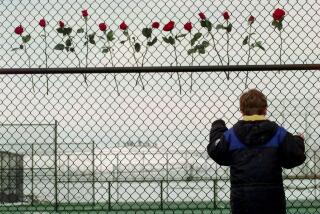Teach Kids to Cope With Bullies, Expert Says
- Share via
At Columbine High School, football players enjoyed picking on students like Eric Harris and Dylan Klebold, once squirting ketchup and mustard on them while calling them cruel names at lunch.
Two weeks later, Harris and Klebold walked into their Colorado school and killed 12 students and a teacher before taking their own lives.
The bullying endured by Harris, Klebold and other students responsible for school shootings doesn’t excuse their behavior, but it helps explain some of their rage, an expert said Saturday at a conference at Crystal Cathedral in Garden Grove.
In an hourlong lecture attended by dozens of Southern California educators, former schoolteacher Barbara Coloroso explored the causes of bullying and gave examples of the effects such cruelty can have.
She spoke on the last day of Crystal Cathedral’s three-day International Conference on Care and Kindness.
Bullying is more pervasive than commonly believed, she said, citing such examples as a redheaded girl whose hair was set on fire, and a stocky boy whose peers took pictures of him in the locker room and posted them on the Internet.
A 2001 federally funded study of students in the sixth to 10th grades found that about three in 10 students are either a victim, a bully or both.
Coloroso’s son was bullied as a child, she said, giving her insight into the roles students, teachers and parents play.
Almost as culpable as the bullies themselves, she said, are bystanders who do nothing.
By teaching children to think for themselves as early as possible, parents play a key role in preventing them from ignoring the actions of bullies, she said.
Those children will then have the inner strength to know when and how to report bullying and to withstand it if they are bullied themselves.
“You don’t want to raise children who are only taught to please others, whether that’s adults or their peers,” said Coloroso, author of “The Bully, the Bullied and the Bystander.”
Just teaching a child to rise above bullying isn’t enough, she said.
“If your child is above it but doesn’t tell an adult, that bully will target someone who can’t deal with it,” Coloroso said.
“That’s not doing anything to stop the bully’s behavior.”
In addition to leading to a desire for revenge, bullying can trigger truancy, introversion and suicide.
Coloroso recounted the story of a 14-year-old girl constantly taunted by three other girls at school and by cellphone. The bullied girl hanged herself with her dog’s leash.
Typical school anti-bullying programs don’t work because teachers are only taught to look for physical or verbal warning signs, and aren’t attuned to the more subtle intimidation tools of rumor, gossip and exclusion.
Worse, she said, is the tolerant attitude many adults still have toward bullying, thinking that it is to be expected in childhood.
“Conflict is a normal part of growing up,” she said. “Bullying is not.”
Coloroso says bullying is typically learned from family members who condone disliking others simply because they are different.
She said bullies put down others because they feel inferior themselves.
“A strong sense of self is an antidote for all three roles: bully, the bullied and the bystander,” she said.
Teachers who attended the lecture agreed that most school programs don’t go far enough.
“The programs don’t address the issues behind bullying,” said Cara Pettite, who teaches sixth- through 12th-graders at a county-run alternative school in Fullerton. “Lectures like this are definitely good to bring up the awareness that bullying is a problem we can’t solve that easily.”
San Jacinto fifth-grade teacher Nicole Bourbeau said her children, ages 5 and 14, are frequently the targets of school bullies.
She said she appreciated Coloroso’s suggestions on how parents should report bullying to school authorities, including tracking the incidents in writing first and making sure administrators have a plan to prevent the bully’s behavior.
“As a parent, it rips your heart out to see your child come home tortured by another student,” Bourbeau said.
“You agonize over what you can do to help them. This helps me figure out concrete ways I can make life easier for my children.”
More to Read
Sign up for Essential California
The most important California stories and recommendations in your inbox every morning.
You may occasionally receive promotional content from the Los Angeles Times.













